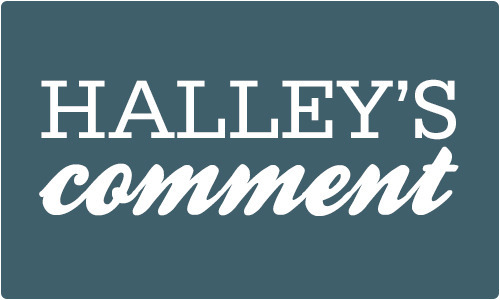Susan Scott's Blog, page 84
June 18, 2014
What It Means To Lead
Fierce CEO, Halley Bock, is currently writing a column for Business 2 Community. We wanted to share with you her most recent article, published Wednesday, June 11th.
Recently in May, I was honored to present at the Women in Real Life (WiRL) Leadership Summit on the topic of “Leadership Beyond Title.” As an executive myself, I’ve seen my fair share of those who lead through title (borrowed authority) and those who lead free of title (earned authority). The former typically run a short-lived course with hit-or-miss results, the latter a long-term life cycle with predictable success.
Always the curious type, I dove deeper into exploring the differences between these two leaders and what sets them apart. As a first stop, I hit up the dictionary to see what we are telling ourselves about leadership and came across a gem. While the definition of “leader” was a bit rigid and smacked of arrogance (the person who commands a group, organization, or country.), the definition of “lead” really struck me. Here it is:
lead
1. to go before or with to show the way.
2. to conduct by holding and guiding.
3. to influence or induce.
4. to guide in direction, course, action, opinion.
Right there in the definition between “leader” and “lead” are the key differentiators between our leader drunk on authority and our leader who gracefully gains authority by way of approach. When I consider the bolded words above, it evokes inner strength and ease: The long, deep rudder quietly guiding the boat as opposed to the captain up top barking orders.
So how does one demonstrate these key aspects of what it means to lead? While many ideas come to mind, here are a few to get you started in a very meaningful way.
Create time to be with one another. If you’ve ever seen a team at work or at play that is deeply bonded, you’ve witnessed a thing of beauty. And something savvy employers dream of. Teams built of tight-knit, deeply forged relationships are more productive and effective than teams loosely strung together. In order to create the cohesion and depth of commitment with each other, go outside and play! Have fun, be spontaneous, and create memorable experiences.
Hold regular 1:1s with staff. Speaking of connection, allow there to be sacred, individual time between yourself and your staff. Set aside 30-minutes to an hour to go deep and focus on them. I like to catch up on their lives by finding some common interests and then launch into theiragenda. That’s right. Their agenda. I prefer this time to be mainly focused on their needs – issues they’re struggling with, opportunities being assessed, unexpected challenges – so that we can really sink our teeth into something meaningful. We always end with a quick check-in on how each of us is doing. It’s a great time to give and receive feedback!
Share the influence of your products or company. Your company and its products exist for very unique reasons specific to you. No matter what you deliver – bolts for jetliners or design services for office space – your purpose is to elevate your trade and better this world in a way that only your company can deliver. Given that we all want to feel our lives are spent with purpose and meaning, never assume your employees automatically get the impact they are having on the world. At monthly meetings, make some time for stories to be shared so that the fulfillment of your mission and vision can nourish everyone on an ongoing and consistent basis.
Guide the corporate culture through your day-to-day interactions. Relationships are developed through conversations. How we show up and interact in those conversations determines the quality of those relationships. For example, if we want open, honest relationships with our team then our conversations must be truthful and free of judgment. If we strive for collaborative relationships then our conversations need to be inviting, curious, welcoming of new ideas. Whereas the quality of our conversations results in the quality of our relationships, the quality of our relationships results in the quality of our culture. An open, collaborative, playful, committed culture requires the same in all the day-to-day interactions happening everywhere in the workplace. As a leader, be mindful of this and ensure your conversations are guiding your culture to the outcome you desire.
All in all, leadership is a quiet exercise. One born of inner strength and a deep, unwavering commitment to supporting all those who surround you. It’s selfless. It’s free of ego. It’s a privilege and it does not come with title. It comes as silently as a luna moth gracing the summer evening. It comes one relationship, one connection, one conversation at a time.
June 16, 2014
Fierce Tip of the Week: Take the First Step to Find a Mentor
Are you ready for a mentor? The first step is simple: identify where you would like guidance or help.
Here are some starting questions:
- What are your short term and long-term goals?
- What gaps are in your skill set?
- Are you looking to network?
- Do you want to better understand an industry or a department?
- Are you looking for someone to reach out to for occasional advice?
This week’s tip is to reflect on where you would like additional support or perspective. Once you have that figured out, you can start to pursue how to connect with the right person or people.
If you have a mentor, how did you find yours? What advice do you have for finding one?
June 13, 2014
Fierce Resources: Getting Outside the Box: The 5 Behaviors of Successful Leaders
This week’s Fierce Resource comes from TLNT.com and was written by Laura Stack.
Getting Outside the Box: The 5 Behaviors of Successful Leaders shares tips on how you can continue to expand your perspective and push the boundaries you may have created without realizing it. Often we come to a point when we know something needs to give, yet we fear the change that lies ahead. Instead of resorting to what is comfortable, take the time to learn what else is out there. Do your research, ask experts, and talk to those around you to expand your learning. You may be surprised at what you find. How will you find your way outside of the box?
“Although overuse has run it into the ground, the lesson remains valid: don’t let your preconceptions, habits, lack of information, and narrow-mindedness keep you from considering all possible aspects of a problem. Get outside your own mental constraints and consider all the information at your disposal, allowing yourself to see beyond your normal, limited horizon.”
To read the full article, click here.
June 11, 2014
Why the Toughest Conversations Matter Most from Blink
This interview was originally published on Blink’s blog. In the segment below, Amy Dickson, Blink’s head of marketing, asks Karen Clark Cole, Blink’s CEO, questions about Fierce and how it has impacted leadership in the company. Shout out to Blink’s amazing work and leadership. Thank you for sharing your journey and successes.
How did you get involved with Fierce? What attracted you to the program?
I met Halley Bock, president and CEO of Fierce, Inc. when she presented at my Women Presidents’ Organization meeting and immediately loved the concepts. During her presentation, Halley talked about committing to one-on-one time with people on a regular basis. I saw huge value in this simple idea, and immediately started scheduling regular one-on-one meetings with my employees. The only hard part was finding the time to do that. I decided to make it a real priority and now block an entire week in my calendar for these meetings twice a year. I also have weekly meetings with some of the leadership people in the company.
As well as those scheduled meetings, my door is always open and I encourage anyone to stop by and talk whenever they want to. In every meeting I always commit to being fully present and move into side-by-side chairs, away from my desk and computer. It’s extremely important to me to show respect for that person’s time and their concerns. While most of this is common sense and what I have always done naturally, the Fierce Principles gave me the data behind what I was doing, helped me fine-tune it to become deliberate and prioritize. The Fierce tools also help me educate others on these ideas. I have several copies of the book that I give out on a regular basis and earmark certain pages for people.
What were your goals when you started using Fierce principles company-wide?
My goal was to have everyone in the company communicating better. The principles are so great because they are easy to understand and can be used right away. I asked everyone to read the book Fierce Conversations – because it deepens the understanding of how to communicate in an honest and sincere way. You don’t even have to read the book end to end to get it – Most of the ideas are bite-sized. It’s not obvious for everyone, especially with so much email now a days, that important and difficult conversations need to be in person. I encourage the Blink staff to think twice about emailing someone, and instead, to get up and walk over to the person’s desk and have a real, live, in-person conversation.
You have the 7 Fierce Principles on the wall of your office. Can you tell me a little bit more about them, and why?
They help keep the principles top of mind and I show them to other people quite a bit. I often pick one and think about it for the day. In cases where I’m having a specific challenge and a principle applies, I will often grab the book and read more about that specific principle to help me through the issue. Each principle has different meanings at different times. All seven principles require practice and constant awareness, and I work hard and train myself to be good at communicating well. It’s an art for sure.
How have the principles changed the way you lead? The way you live?
I live more clearly. I didn’t used to have words to tell someone about his or her own impact, and now I can really frame it up quickly and clearly. This is helpful for both parties.
Principle #6 (Take responsibility for your emotional wake) is a great example: It really resonates with me as someone who has grown professionally with my role at Blink changing over the last 14 years. I know now that sometimes what I don’t say has as big of an impact as what I do say. I try to teach other leaders at Blink that they have this type of impact as well, and that they need to take it seriously and be aware of the emotional wake they may cause – both good and bad.
Does any one principle resonate more with you? Rise above the rest?
I have two favorites: #3 (Be here, be prepared to be nowhere else) and #6 (Take responsibility for your emotional wake). They are always top-of-mind for me. I expect these of myself and expect them of others around me as well – both at work and at home.
Can you tell me a story or about a situation where you used a Fierce Principle to good effect? What did you do? What happened?
#3 and #6 again—Being present and responsible are how I am in meetings. I ask people to come prepared to be the same. It really comes down to respecting each other. If someone has planned a meeting, they have something to say and everyone who agrees to attend should listen and participate in that meeting as though it’s the most important thing they could be doing at that time. If they can’t honestly say that to themselves, they should not attend, and that’s okay.
When everyone is fully present in the meeting, it allows us to be more efficient, engaged, and productive. People need to be heard to feel valued. When your job in a meeting is to fully listen and engage, it makes it a whole lot easier than when you are expected to multi-task, resulting in two or three things done half-heartedly. When people are engaged, you get things done; have more interesting, richer conversations and better results.
Has using Fierce principles helped resolve issues?
Having a difficult conversation is not something people usually look forward to, but I’ve learned that using the Fierce tools, with lots of practice, it gets much easier: The more you do it, the less daunting it becomes. The outcome is so incredibly worth it, that you begin to look forward to the outcome and start to feel less overwhelmed about the process. It becomes more of a positive thing. Fierce Conversations gave us the courage to acknowledge the reasons why we didn’t look forward to difficult conversations, and gave us the courage and tools to get through it. We know it’s going to be hard and that’s okay.
Read the original piece, here.
June 9, 2014
Fierce Tip of the Week: Check-In Now
Step back and reflect on all of the people you will interact with this week – inside and outside of work. Do you have a gut feeling about something that needs to be talked about?
Now is the time to do something about it.
I’m not saying that your instinct about a situation is necessarily correct. Many times our instincts are fueled by our own fears or thoughts around a certain situation. What you may perceive as an issue, may be something entirely unrelated.
However…what if it isn’t? Is it worth glazing over?
This week’s tip is to connect with the person you most need to check-in with. Be specific and share what you sense.
The worst that can happen is you are wrong. Just be prepared to be.
June 6, 2014
Fierce Resources: 7 Things You Can Do on Friday to Make Monday Awesome
This week’s Fierce Resource comes from Inc.com and was written by Kevin Daum.
7 Things You Can Do on Friday to Make Monday Awesome addresses the end of the week workplace lull most commonly seen on Friday, say around 1 pm. While the thought of the weekend starting early is welcoming, think about how much better your Monday will be with a little extra preparation time on Friday. Instead of taking off early, decide what action item you will take to make Monday more gratifying for you. Determine the “thing” that motivates you most about work. Schedule that first thing on Monday morning and see the difference it makes in your entire week. What motivates you?
“You don’t get a lot of help from your colleagues because the afternoon Friday lull is a commonly shared experience. Everyone’s already thinking about the weekend and ready to go home, so productivity drops. But instead of giving in to the impulse to window gaze and daydream, you can use the opportunity to get next week off to an awesome start.”
To read the full article, click here.
June 4, 2014
Making Fierce Conversations Count – In Business and in Life
Fierce CEO, Halley Bock, was interviewed in this Huffington Post article by Colin Hunter. It was originally posted here.
Continuing the theme of last month’s interview with Tim Brown, I have once again re-visited my shelf of inspirational leadership books. This month, Halley Bock, President and CEO of Fierce, Inc., the company behind the best-selling book Fierce Conversations, Achieving Success at Work and in Life One Conversation at a Time, has agreed to share some of the insights included in the book.
After reviewing Fierce Conversations in a recent blog post, it became very apparent that this book is relevant not only to those at CEO level, but to anyone who has ever felt that there is no room for emotion in the dog-eat-dog business world. As our company is built on the notion of being refreshingly direct, I was keen to talk to the people behind the book that has inspired businesses around the globe, and my business in particular.
Although the art of honest conversation might not seem like such a difficult concept, many leaders struggle to encourage and embrace them. Fortunately, Bock and her team extol the virtues of making ‘fierce conversations’ not only a way of conducting business, but a way of life. The core message of the book is to use exchanges to bring about change through confrontation, overcoming fear or encouragement of opinion – ultimately making conversations count. Bock tells us how these concepts can come to life.
How have you been involved with the book, Fierce Conversations, and how has it shaped your business today?
Fierce Inc. is a global leadership development and training company that drives results by improving workplace communication. Many of our training curriculums are based upon the techniques, methodologies, and philosophies explored in both Fierce Leadership andFierce Conversations.
What is the fundamental premise of the book from your perspective?
The fundamental idea of Fierce Conversations is that there is enormous power in conversations. Everything we do – our work, our relationships, and in fact, our very lives – succeed or fail gradually, then suddenly, one conversation at a time.
How do you encourage people to have fierce conversations in business or in their private life? What holds them back, and what ultimately helps them to overcome these challenges?
By challenging them to come out from behind themselves and interrogate reality. People often shy away from asking uncomfortable questions, because they fear what the answers may be. This procrastination in confronting crucial issues only amplifies the core problem, leading to further complications.
What was the overall reaction to the book?
The reaction to both books has been very positive to this day. We still get letters from organisational leaders, business managers, schoolteachers, and others, sharing their personal stories on how the books have helped them change course and become more effective team members and team builders.
What makes the Fierce Conversation approach to business/leadership different?
The Fierce approach has a positive, transformative effect with some very distinct features. Unlike traditional top-down business and management structures, where leaders resemble dictators, directing, telling, and imposing their views on organisations, the Fierce approach is radically different. Employees are invited to participate in decision-making, and their contributions are encouraged and sought after. This makes for a more transparent workplace, highly engaged workers, and richer relationships among co-workers that improve productivity and performance.
What makes the Fierce Conversation approach to business/leadership sustainable?
Primarily because it does not require costly outside resources, it utilises resources that organisations always have in their possession – the talent within their workforce.
What other leadership books would you recommend?
Outliers by Malcolm Gladwell, which offers an astounding peek into what really makes great leaders tick. Blue Ocean Strategy by Renée Mauborgne and W. Chan Kim, a game-changing look at what it means to compete and win. And Good to Great by Jim Collins, which turns traditional thinking about “what makes an organisation great” on its ear, supported by irrefutable research.
What predictions do you have for the future with respect to leadership in business? What will success look like?
I think great leaders of the future will be facing the same problems that our current leaders face. Driving business results while simultaneously establishing a healthy work/life balance for their teams.
What advice would you give to up-and-coming business leaders?
New leaders are entering a work environment that can often be impersonal, with employees working remotely, primarily communicating electronically, and rarely meeting with co-workers. A leader’s ability to connect can be seriously compromised. Constant, dedicated development of interpersonal skills, such as soliciting other’s perspectives, building teams, and actively listening is crucial in the modern working world.
June 2, 2014
Fierce Tip of the Week: Stick with It
Walter Elliot stated, “Perseverance is not a long race; it is many short races one after the other.” I can relate to this quote a lot lately – both figuratively and literally.
I have been training the past few months for my first olympic distance triathlon. I have always wanted to finish one, so I have been filled with joy from all the learning and areas of growth I have seen in myself. However, it has also brought out doubts I didn’t even know I had about myself and my own abilities.
Being an overachiever, “type A” kinda gal, quitting rarely comes into my mind as an option when I set my mind to do something. It has really caught me offguard how many times I have wanted to quit.
I have asked myself: Why am I even doing this? There are so many new things to learn from open water swimming tricks, to buying new gear, to preparing transition areas. It can feel so overwhelming at times – to the point that it feels like too much. Then pile on other life stuff: buying a new home, moving, work projects, volunteer commitments, etc. The list goes on and on.
However, it is all a series of short races (goals), day-by day, that get us closer or farther from what we really want to accomplish in life. I am choosing every day to stay committed – to persevere.
What goals are on your list that scare you?
This week’s tip is to commit to one of those goals and stick with it. Share with others around you what that goal is, and it may surprise you how many people pitch in. People have volunteered to bike with me, run with me, swim with me, and cheer for me. Their energy has given me new excitement.
After you choose the goal, reasons may come up for you along the way, probably in unexpected form, about why you can’t do it or why now is not the best time.
The thing is…now is all you have.
What goal are you going to stick with?
May 30, 2014
Fierce Resources: 6 Ways Pushing Past Your Comfort Zone Is Critical To Success

This week’s Fierce Resource comes from Forbes.com and was written by Kathy Caprino.
6 Ways Pushing Past Your Comfort Zone Is Critical To Success shares the importance of stepping out of your comfort zone and into a place where you find growth and experiences. Those will help lead you to becoming your authentic self and just maybe, the self you’ve always wanted to be. What have you always wanted to try? Regardless of how difficult or intimidating, look it directly in the eye and go get it. What are you waiting for?
“I’ve seen in my work at Walmart that maintaining placement as the top retailer requires staying ahead of change and a willingness to ‘swim upstream.’ So much of what everyone does at Walmart – whether it is the size or scale of an endeavor, or launching an entirely new idea – has never been done before. This can be daunting because it includes an element of risk and necessitates people stepping out of their comfort zones.”
To read the full article, click here.
May 28, 2014
From the Founder of WiRL, Mitch Shepard: 5 Steps to a More Balanced Life
The other day, my twenty-something banker said something that made my day! “Mitch,” he said, “I‘ve told several people about your values board. I was so inspired by it. I’m definitely going to do that when I get married and have a family.” Last fall, while visiting our home to have us sign some paperwork, my banker had noticed the large 36-inch-by-48-inch corkboard filled with meaningful words and colorful pictures. In answer to his inquiring look, I told him it was our values board and explained how it came to be…
About six years ago, I was sitting in the rocking chair holding my baby daughter (who’s now seven) when a friend called to tell me a story that would forever inspire me and shape my family life. My friend explained that at school that day her daughter, a senior in high school at the time, had been asked, “What’s the one thing your mother hopes she’s instilled in you by now?” My friend’s daughter—along with her classmates—shared her answer and then wrote it on a piece of paper that she folded up and tucked in her pocket. That evening, she posed the question to her mom, my friend, who described her panic at the thought of, “What if, after all this time, I learn that I haven’t taught my daughter the right stuff?” With a rapidly beating heart, my friend gave her answer: “Forgiveness.” From her pocket, her daughter removed the piece of paper and showed her mother the word she’d written on it earlier that day: “Forgiveness.” (This story still makes me cry!) As I held my sweet baby girl, I realized how much influence I would have over this tiny person and what she would grow to value. I didn’t want anything to be left to chance. So, my husband and I got clear on our values. We asked each other: What do we stand for as a family—what are the values we hold near and dear? What matters most to us? What values do we hope to instill in our children? What do we want thecore purpose of our lives to be? What do we want for ourselves individually, for our relationship as a couple, and for our family as a whole?
We finally edited our answers down to the following values words: Family, Health, Fun, Adventure, Helping Others, Gratitude, Team, Learning, Wealth. We painted each word in watercolor, as if to let the meaning soak in, and then created a huge corkboard (our first and only craft project as a couple—see photo!) and on it placed the words, along with photographs, poems, cards and pictures that depicted what they mean to us. It was a meaningful project—and has become a meaningful lens through which to view our life and our decisions. This board has served as a kind of North Star in our marriage, family, home, careers and lives. Whenever we feel out of balance, checking in with our values is the fastest way to refocus, reprioritize and rebalance—which makes it my absolute Number One tip for a life that feels peaceful and balanced.
To read the five steps, read here.
This blog was originally posted on the WiRL blog by Mitch Shepard. Susan Scott, Fierce Founder, and Halley Bock, Fierce CEO, both had sessions at the WiRL Summit 2014.
Susan Scott's Blog
- Susan Scott's profile
- 861 followers











